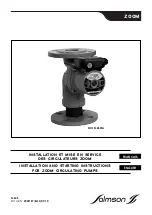
7
Installation
(continued)
2.
Before starting, remove all flow
restrictions downstream of the pump
to allow initial operation with as low a
back pressure as possible.
3. Start the pump at the slowest speed pos-
sible and, if possible, with a lubricating
fluid. Zenith B-9000 pumps must never be
run without a fluid.
Watch the point of
discharge for evidence of fluid. If no
discharge is seen after a reasonable
length of time, shut down the pump
and check for obstructions in the sys-
tem and proper pump rotation. The
term “sufficient length of time” is sub-
jective, and cannot be quantified
because of differences in installation.
If, for example, a connection can be
broken within a few inches of the
pump outlet port, the flow would be
evident with several seconds. If the
distance between the pump outlet
and the point of final discharge is
long, more time would be needed
before flow is confirmed.
Note:
The pump will discharge a cloud of
bubbles when it is started, but this
will subside when the air is purged
from the pump. This is a normal
part of pump startup.
4.
When satisfactory operation is
achieved, the pump and system can
gradually be brought up to normal
operating speed and pressure.
4.
Listen for any sounds of distress
when first starting the pump and turn
the pump off immediately if any are
heard. Investigate for causes of
distress.
5.
If, at any time during operation, the
pump does not appear to be running
smoothly, stop the pump immediately
to avoid serious internal damage.
Cleaning,
Inspection
and Repair
Remember:
Zenith metering pumps are
made for exact duty. In order to develop
high pressure and minimize slip, the
clearance between the metering gears
and their housing must be as small as
possible, yet large enough to allow ade-
quate lubrication. All parts are machined
to extreme accuracy. Critical dimensions
are held between one and two ten-
thousandths of an inch (.0001"/.0002").
Accurate performance is dependent
upon proper handling. Please handle
the pumps with extreme care, and if pos-
sible, set aside a separate clean area for
pump maintenance and repair.
It is recommended that pump users
institute a program for dimensional
inspection of critical parts in order to
keep maintenance and operating costs
to a minimum. By noting the performance
of a pump immediately before removing
it from service and correlating the per-
formance to measured component wear,
the maximum limit for the pump’s critical
components can be established.
Additionally, the service life of the pump
can be predicted and downtime can be
scheduled accordingly.
If necessary, any Zenith precision
metering pump requiring maintenance can
be returned to the factory for complete
repair and overhaul. For a large number
of pumps, Zenith offers a contract repair
service which helps to reduce repair
costs and delivery time. Zenith Pumps
also offers pump maintenance seminars.
For more information concerning Zenith
pump repair services, please contact our
Customer Service Department.
Summary of Contents for B-9000 Series
Page 1: ......


































